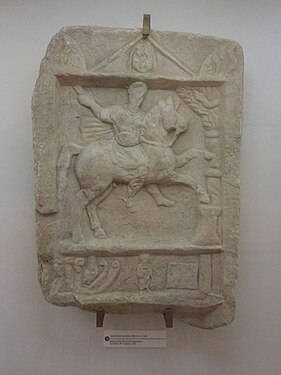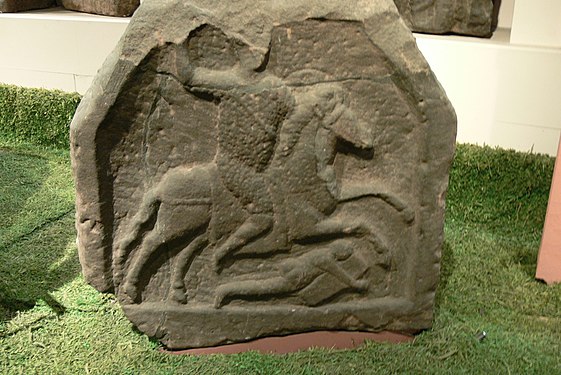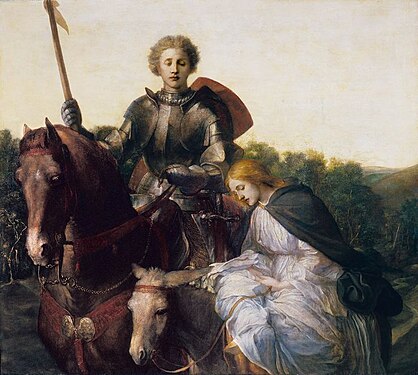
Saint George and the Dragon
In a legend, Saint George—a soldier venerated in Christianity—defeats a dragon. The story goes that the dragon originally extorted tribute from villagers. When they ran out of livestock and trinkets for the dragon, they started giving up a human tribute once a year. This was acceptable to the villagers until a princess was chosen as the next offering. The saint thereupon rescues the princess and kills the dragon. The narrative was first set in Cappadocia in the earliest sources of the 11th and 12th centuries, but transferred to Libya in the 13th-century Golden Legend.[1]
For other uses, see Saint George and the Dragon (disambiguation).
The narrative has pre-Christian origins (Jason and Medea, Perseus and Andromeda, Typhon, etc.),[1] and is recorded in various saints' lives prior to its attribution to St. George specifically. It was particularly attributed to Saint Theodore Tiro in the 9th and 10th centuries, and was first transferred to Saint George in the 11th century. The oldest known record of Saint George slaying a dragon is found in a Georgian text of the 11th century.[2][3]
The legend and iconography spread rapidly through the Byzantine cultural sphere in the 12th century. It reached Western Christian tradition still in the 12th century, via the crusades. The knights of the First Crusade believed that St. George, along with his fellow soldier-saints Demetrius, Maurice, Theodore and Mercurius had fought alongside them at Antioch and Jerusalem. The legend was popularised in Western tradition in the 13th century based on its Latin versions in the Speculum Historiale and the Golden Legend. At first limited to the courtly setting of Chivalric romance, the legend was popularised in the 13th century and became a favourite literary and pictorial subject in the Late Middle Ages and Renaissance, and it has become an integral part of the Christian traditions relating to Saint George in both Eastern and Western tradition.
In the well-known version from Jacobus de Voragine's Legenda aurea (The Golden Legend, 1260s), the narrative episode of Saint George and the Dragon took place somewhere he called "Silene", in Libya.[16][17]
Silene in Libya was plagued by a venom-spewing dragon dwelling in a nearby pond, poisoning the countryside. To prevent it from affecting the city itself, the people offered it two sheep daily, then a man and a sheep, and finally their children and youths, chosen by lottery. One time the lot fell on the king's daughter. The king offered all his gold and silver to have his daughter spared, but the people refused. The daughter was sent out to the lake, dressed as a bride, to be fed to the dragon.
Saint George arrived at the spot. The princess tried to send him away, but he vowed to remain. The dragon emerged from the pond while they were conversing. Saint George made the Sign of the Cross and charged it on horseback, seriously wounding it with his lance.[a] He then called to the princess to throw him her girdle (zona), and he put it around the dragon's neck. Wherever she walked, the dragon followed the girl like a "meek beast" on a leash.[b]
The princess and Saint George led the dragon back to the city of Silene, where it terrified the population. Saint George offered to kill the dragon if they consented to become Christians and be baptized. Fifteen thousand men including the king of Silene converted to Christianity.[c] George then killed the dragon, beheading it with his sword, and the body was carted out of the city on four ox-carts. The king built a church to the Blessed Virgin Mary and Saint George on the site where the dragon died and a spring flowed from its altar with water that cured all disease.[18]
Only the Latin version involves the saint striking the dragon with the spear, before killing it with the sword.[19]
The Golden Legend narrative is the main source of the story of Saint George and the Dragon as received in Western Europe,
and is therefore relevant for Saint George as patron saint of England.
The princess remains unnamed in the Golden Legend version, and the name "Sabra" is supplied by Elizabethan era writer Richard Johnson in his Seven Champions of Christendom (1596). In the work, she is recast as a princess of Egypt.[20][21] This work takes great liberties with the material, and makes St. George marry Sabra[d] and have English children, one of whom becomes Guy of Warwick.[22]
Alternative names given to the princess in Italian sources still of the 13th century are Cleolinda and Aia.[23] Johnson also supplied the name of Saint George's sword: "Ascalon".[24] The story of St. George, as the Red Cross Knight and the patron saint of England, slaying the dragon, which represents sin, and Princess Una as George's true love and an allegory representing the Protestant church as the one true faith, was told in altered fashion in Edmund Spenser's The Faerie Queene.[25] [26]
Literary adaptations[edit]
Edmund Spenser expands on the Saint George and the Dragon story in Book I of the Fairy Queen, initially referring to the hero as the Redcross Knight.
William Shakespeare refers to Saint George and the Dragon in Richard III ( Advance our standards, set upon our foes Our ancient world of courage fair St. George Inspire us with the spleen of fiery dragons act V, sc. 3), Henry V ( The game's afoot: follow your spirit, and upon this charge cry 'God for Harry, England, and Saint George!' act III, sc. 1), and also in King Lear (act I).
A 17th-century broadside ballad paid homage to the feat of George's dragon slaying. Titled "St. George and the Dragon", the ballad considers the importance of Saint George in relation to other heroes of epic and Romance, ultimately concluding that all other heroes and figures of epic or romance pale in comparison to the feats of George.[41]
The Banner of St George by Edward Elgar is a ballad for chorus and orchestra, words by Shapcott Wensley (1879).
The 1898 Dream Days by Kenneth Grahame includes a chapter entitled "The Reluctant Dragon", in which an elderly Saint George and a benign dragon stage a mock battle to satisfy the townsfolk and get the dragon introduced into society. Later made into a film by Walt Disney Productions, and set to music by John Rutter as a children's operetta.
In 1935 Stanley Holloway recorded a humorous retelling of the tale as St. George and the Dragon written by Weston and Lee.
In the 1950s, Stan Freberg and Daws Butler wrote and performed St. George and the Dragon-Net (a spoof of the tale and of Dragnet) for Freberg's radio show. The story's recording became the first comedy album to sell over a million copies.
Margaret Hodges retold the legend in a 1984 children's book (Saint George and the Dragon) with Caldecott Medal-winning illustrations by Trina Schart Hyman.
The Forever Knights that serve as a recurring antagonist faction in the Ben 10 are revealed in the third series Ben 10: Ultimate Alien to have been founded by Sir George from the legend of Saint George and the Dragon, with the tale directly referenced by name. The dragon that George fought is depicted as a shapeshifting extradimensional demon named Dagon, worshipped by a cult called the Flame Keepers’ Circle that goes to war against the Forever Knights. Series main antagonist Vilgax takes advantage of his true form’s coincidental resemblance to Dagon’s true appearance to manipulate the Flame Keepers’ Circle into helping him find the heart of Dagon, which George had cut out and sealed with the Ascalon, depicted here as a sword of alien origin created by Azmuth prior to inventing the Omnitrix.
Samantha Shannon describes her 2019 novel The Priory of the Orange Tree as a "feminist retelling" of Saint George and the Dragon.[42]
Heraldry and vexillology[edit]
Coats of arms[edit]
Reggio Calabria used Saint George and the dragon in its coat of arms since at least 1757, derived from earlier (15th-century) iconography used on the city seal. Saint George and the dragon has been depicted in the coat of arms of Moscow since the late 18th century, and in the coat of arms of Georgia since 1991 (based on a coat of arms introduced in 1801 for Georgia within the Russian Empire).













